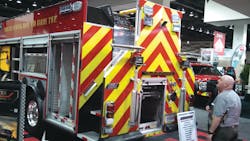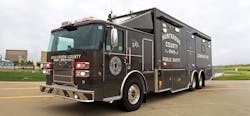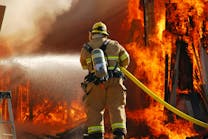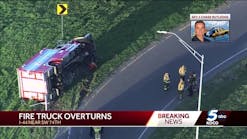When it comes to innovative apparatus, you know you’ve got one when there’s nothing else like it in the country. That’s what the firefighters with the Delton, Mich., Fire Department have come up with.
The apparatus is equipped with a one-of-a-kind rear elevated control panel. That’s going to require some explanation. Think of a traditional custom cab and chassis fire pumper with the pump located midship, just behind the transmission. Then, move the controls to the rear of the apparatus, kind of where you might find the hose bed on a traditional pumper. The pump control panel looks like many other top-mount control panels, but it’s accessed by two staircases on each side of the apparatus. You probably have to look at the photos to get an idea.
Delton Fire Chief Gene Muskovin said his firefighters, all volunteer, paid on call, wanted to improve on the apparatus they currently have and add features they thought would help them do the job better.
“The whole premise was safety and visibility,” Muskovin said. “We have side-mount pump panels now and we’re always in the ditch or in the roadway depending on the way the apparatus is parked.”
They looked at alternatives, including traditional top-mount pump panels, just behind the cab, but they felt the visibility to the front and rear was compromised by the height of the cab and the length of the apparatus to the rear.
A rear-mount pump was considered as well. “But then we thought the operator’s back is to traffic and that wasn’t a good idea either,” Muskovin said. Moving the control panel to the sides of the rear didn’t improve the roadway or ditch problem either.
Then, there’s the perennial problem of having discharges and intakes snaking around the operator’s feet as well, not to mention the cross lay pre-connected hoses being right at head height, the chief said.
“We’ve been throwing around ideas for a while and we came up with this rear elevated design,” Muskovin said, adding that there’s no discharges by the operator and the visibility and safety is unmatched. “If you can’t see the fire from back there, you’ve parked way too close,” the chief quipped.
Delton, which is a rural area with no hydrants, relies on tanker shuttles for water supply and having a rear suction intake helps them keep drop tanks directly behind the apparatus and helping to keep at least one lane of a roadway open during operations, Muskovin said.
To help make their dream apparatus a reality, they called in Spencer Manufacturing, a builder in South Haven, Mich., a company they have had build three other apparatus in the Delton fleet.
“We had some ideas about what we wanted and we called in Grant (Spencer) and he helped us come up with the design,” Muskovin said.
The “chicken scratch” on a yellow piece of legal pad paper was the original concept which turned into concept engineered drawings to the reality of a real, red apparatus.
“It’s pretty amazing they could take that scratching and make turn it into a fire truck,” Muskovin said.
Originally, the Delton firefighters had an idea of having a ladder access the rear pump operator’s platform, but Spencer improved upon that idea with the staircase idea on both sides of the apparatus. Muskovin said that while the stairs are steep, there are railings and it’s safer than a ladder. Having access from both sides also means the operator will never have to step into traffic or into a ditch, depending on how the apparatus is parked.
“When I first saw it, I liked the idea of the extra space acting as a crumple zone,” Muskovin said. “That extra two feet gives the operator just that much more protection.”
Delton firefighters only had a few other requirements, one being that it carries at least 1,000-gallons of water and can deliver 1,250 gpm through the rear suction within certain height and length restrictions. Spencer did that and more, Muskovin said, noting the new apparatus carries 1,280-gallons of water and with a Hale 1,500 gpm pump, the apparatus can deliver the required water as well.
By moving the pump controls to the rear, space above the physical pump, usually the dunnage area, is freed up for a transverse compartment where backboards and a Stokes basket is stored.
An added benefit, that wasn’t really considered when specifying the apparatus is quiet operations. Muskovin said a recent pump training class illustrated the low-level noise at the control panel. He said normal conversation could be carried on while a portable ground monitor and a handle both flowed 150 psi.
“We had no idea it was going to be that quiet,” Muskovin said of the pleasant surprise benefit. He said it was so quiet that while the apparatus was flowing that amount of water, the hydraulic generator on top of the rig was audible at the control panel – something that is usually drown out by the diesel engine and pump sounds.
And the visibility is great too, he said, noting that the pump operator has an unobstructed visibility of 360 degrees.
Muskovin said he realizes that not everyone would go for Delton’s dream, but his firefighters have embraced the concept from the get-go.
“They have no problem with the electronic valve controls,” Muskovin said, noting that without that feature, the whole concept wouldn’t work. “You couldn’t run push rods that far.”
Muskovin said the Akron Brass electric valves have manual overrides with a hex head nut on the top which can be controlled with an air impact or battery operated wrench, or even a manual hand-held wrench. He said his firefighters are considering leaving some sort of tool right in the pump house in the unlikely event something happens to a valve. “At least we could close that valve and continue operating,” Muskovin said adding that it’s extremely unlikely that anything would happen to any more than one valve at a time. “They’ve been around long enough that I don’t have any problem with them.”
The apparatus was introduced in Indianapolis this spring and Muskovin said he noticed varied reactions.
“There are people who absolutely loved it and there was some that didn’t,” Muskovin said. “Either you love it or you hate it.”
There’s a lot to love about the apparatus that’s built on a Spartan Metro Star cab and chassis with an extreme duty interior. Muskovin said it’s the first custom cab and chassis for Denton’s fleet which includes two pumpers, a tanker, a brush truck and a converted ambulance used for medical first responder calls.
“We’re really looking forward to all the extra room in the apparatus,” Muskovin said, adding that the department will now be able to move SCBAs to inside the cab, something new for the department that runs about 100 fire related calls annually. The department runs an additional 300 or so medical calls per year.
“We’ll save a few minutes by having our gear on before we get to the scene,” the chief said, adding that his firefighters will learn to don their SCBAs while still belted in their seats.
Muskovin said his firefighters are also looking forward to significantly increasing the available space on the apparatus.
The aluminum Spencer body features 24-inch compartment depths compared to the 12-inch depth shelves on the Ford-based pumper it will be replacing.
It also has pull out trays and tool boards, more firsts for the department.
“We’re going to be looking for more equipment to fill up all those empty compartments,” Muskovin joked, adding that his department’s front-line pumper has “equipment placed on equipment.”
The apparatus is also equipped with a FRC Turbofoam system, an APR tank, a low through-the-tank ladder tunnel, ROM roll-up doors, an FRC pressure governor, a Trident dual auto primer, D&S custom covers, a Command Light tower and a SmartPower 8,000-watt generator.
Muskovin said the price of the apparatus was discounted at $500,000 and Spencer Manufacturing was allowed an extra two months to showcase the apparatus and demonstrate it after the agreed upon delivery date.
Spencer’s plant is about an hour and a half from Denton which made it easy to do business, Muskovin said.
“We didn’t bid anything else,” the chief said. “We worked with (the company) and they came up with what we wanted at a discounted price.” The fact that the company had built three other units for the department also made the selection that much easier.
“Working with Spencer was amazing,” Muskovin said. “They are a mom-pop operation that’s just grown and grown. Their facility is amazing. …They took our dreams and made them a reality.”
ED BALLAM is the product and industry editor for Firehouse, a captain with the Haverhill Corner, N.H., Fire Department, and a National Registered EMT. He is also a Deputy Forest Fire Warden for the New Hampshire Division of Forests and Lands. Professionally, he's been a journalist for over 30 years working for a variety of publications, including employment as managing editor of a national fire service trade journal for more than a decade. You can contact him at [email protected].









